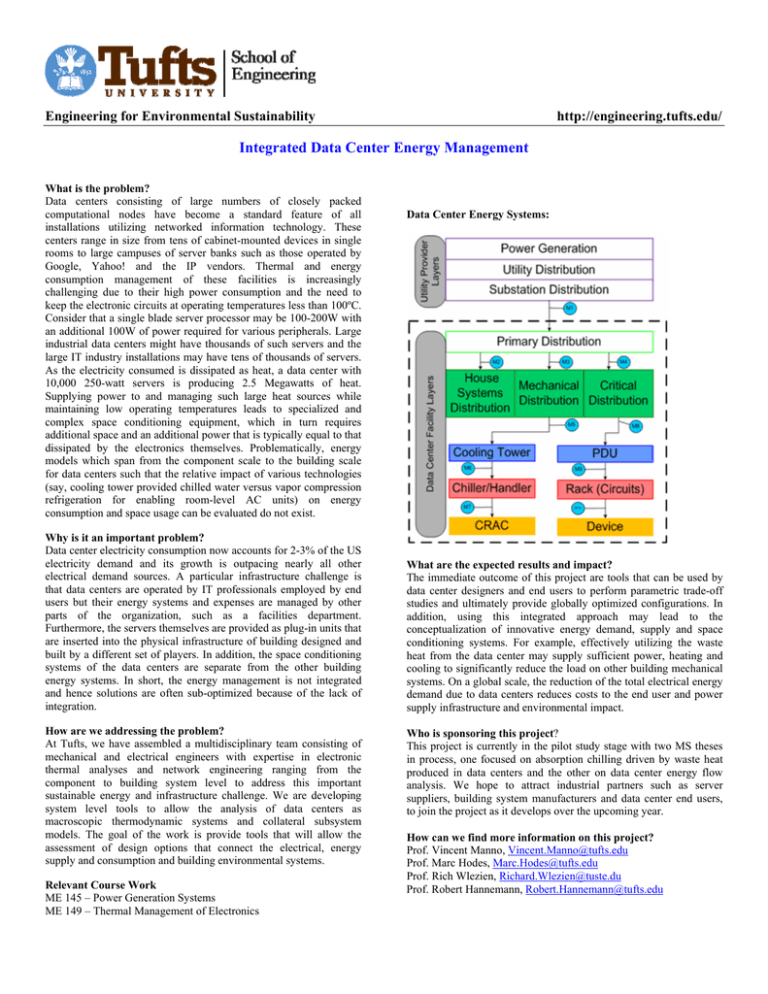Document 11588444
advertisement

Engineering for Environmental Sustainability http://engineering.tufts.edu/ Integrated Data Center Energy Management What is the problem? Data centers consisting of large numbers of closely packed computational nodes have become a standard feature of all installations utilizing networked information technology. These centers range in size from tens of cabinet-mounted devices in single rooms to large campuses of server banks such as those operated by Google, Yahoo! and the IP vendors. Thermal and energy consumption management of these facilities is increasingly challenging due to their high power consumption and the need to keep the electronic circuits at operating temperatures less than 100ºC. Consider that a single blade server processor may be 100-200W with an additional 100W of power required for various peripherals. Large industrial data centers might have thousands of such servers and the large IT industry installations may have tens of thousands of servers. As the electricity consumed is dissipated as heat, a data center with 10,000 250-watt servers is producing 2.5 Megawatts of heat. Supplying power to and managing such large heat sources while maintaining low operating temperatures leads to specialized and complex space conditioning equipment, which in turn requires additional space and an additional power that is typically equal to that dissipated by the electronics themselves. Problematically, energy models which span from the component scale to the building scale for data centers such that the relative impact of various technologies (say, cooling tower provided chilled water versus vapor compression refrigeration for enabling room-level AC units) on energy consumption and space usage can be evaluated do not exist. Why is it an important problem? Data center electricity consumption now accounts for 2-3% of the US electricity demand and its growth is outpacing nearly all other electrical demand sources. A particular infrastructure challenge is that data centers are operated by IT professionals employed by end users but their energy systems and expenses are managed by other parts of the organization, such as a facilities department. Furthermore, the servers themselves are provided as plug-in units that are inserted into the physical infrastructure of building designed and built by a different set of players. In addition, the space conditioning systems of the data centers are separate from the other building energy systems. In short, the energy management is not integrated and hence solutions are often sub-optimized because of the lack of integration. How are we addressing the problem? At Tufts, we have assembled a multidisciplinary team consisting of mechanical and electrical engineers with expertise in electronic thermal analyses and network engineering ranging from the component to building system level to address this important sustainable energy and infrastructure challenge. We are developing system level tools to allow the analysis of data centers as macroscopic thermodynamic systems and collateral subsystem models. The goal of the work is provide tools that will allow the assessment of design options that connect the electrical, energy supply and consumption and building environmental systems. Relevant Course Work ME 145 – Power Generation Systems ME 149 – Thermal Management of Electronics Data Center Energy Systems: What are the expected results and impact? The immediate outcome of this project are tools that can be used by data center designers and end users to perform parametric trade-off studies and ultimately provide globally optimized configurations. In addition, using this integrated approach may lead to the conceptualization of innovative energy demand, supply and space conditioning systems. For example, effectively utilizing the waste heat from the data center may supply sufficient power, heating and cooling to significantly reduce the load on other building mechanical systems. On a global scale, the reduction of the total electrical energy demand due to data centers reduces costs to the end user and power supply infrastructure and environmental impact. Who is sponsoring this project? This project is currently in the pilot study stage with two MS theses in process, one focused on absorption chilling driven by waste heat produced in data centers and the other on data center energy flow analysis. We hope to attract industrial partners such as server suppliers, building system manufacturers and data center end users, to join the project as it develops over the upcoming year. How can we find more information on this project? Prof. Vincent Manno, Vincent.Manno@tufts.edu Prof. Marc Hodes, Marc.Hodes@tufts.edu Prof. Rich Wlezien, Richard.Wlezien@tuste.du Prof. Robert Hannemann, Robert.Hannemann@tufts.edu






